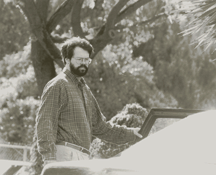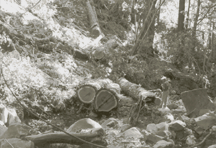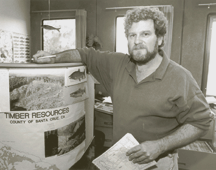Cutting to the Chase
Open-Door Policy: Environmental charges, as well as state and county citations, have been leveled against the logging practices on a parcel of land near Corralitos co-owned by George Golitzin (pictured) and Eric Diesel.
While timber clearing at Grizzly Flats has ground to a halt for now, a real jolt to the environment may just be starting right next door
By Kelly Luker
THE FORESTS OF GRIZZLY FLATS are safe. For now, at least. That the proposed logging plans by the city of Watsonville for this 200-acre parcel near Corralitos have been stalled indefinitely is a testament to the power of publicity that environmentalists have generated for the past two years.
Yet while Grizzly Flats cranked up a dizzying array of urgent faxes to the press, news articles and court appeals, it appears the real story was happening right next door with Timber Harvest Permit Number 1-94-353, better known as the Golitzin-Diesel project. And there is evidence to suggest that what happened on that parcel would make what is proposed at Grizzly Flats a nature study by comparison.
About 160 acres co-owned by Eric Diesel of Los Altos Hills and George Golitzin of San Jose surrounds Rattlesnake Creek, a pristine tributary that tumbles 1,000 feet over giant river boulders from the Santa Cruz Mountains summit down to Corralitos Creek. At this time of year, waterfalls carom off the giant boulders, the spray netting rainbows as the water rushes down the deep gully it has carved into the mountainside. It offers much of the spectacular beauty that many drive to Yosemite to witness, yet it exists quietly in our own back yard.
Although a few details about what happened at Golitzin-Diesel made the news, it went largely unnoticed by all but a few neighbors and Sierra Club folks. It may have managed to fly under the radar because it was privately owned, unlike the city-owned Grizzly Flats. Maybe "Golitzin-Diesel" doesn't have the same sexy ring as Grizzly Flats. Or maybe it was just too damned hard for most folks to crawl up the side of the mountain through the poison oak to see for themselves what was going on.
If they had, they would have seen brush, tree limbs and logs choking the creek, thousands of yards of silt and sediment that had washed into the waters (a threat to local steelhead trout), and a host of other violations that have been noted by both the California Department of Forestry and the Santa Cruz County Planning Department. A closer examination would reveal something else swirling and eddying in those crystal-clear waters of Rattlesnake Creek--the mystery of who is really protecting our forests.
As that mystery unfolds, it is clear that the answer, although too late for the Golitzin-Diesel property, will affect the destiny of the redwoods and watershed from Grizzly Flat and nearby Gamecock Canyon to the embattled Headwaters Forest near the Oregon border. Because clue after clue is convincing environmentalists that, indeed, it may be a case of the fox guarding the henhouse.
Road to Ruin
THERE WAS SOME grumbling about the Golitzin-Diesel project, of course. Neighbors Harold Short and Ed Wilson raised a stink when they heard about the plans. And Betsy Herbert, with Citizens for Responsible Forest Management, went so far as to take the project to task in the Sierra Club's Ventana newspaper. But it was the gang down at the Santa Cruz County Planning Department--David Hope, Matt Baldzikowski and their boss Dan Shaw--who are still angry, convinced that what happened on Golitzin-Diesel was a crime. The question for the public is, why isn't anybody paying?
There is reasonable doubt that logging was the principal interest of Golitzin and Diesel to begin with. When contacted by phone, Golitzin says, "The original intention was to hold the property." He also was quoted as saying in a 1995 Santa Cruz County Sentinel article that he and Diesel bought the property as an investment and decided to log some of it for income. However, Dave Hope has a much different picture.
Hope, who takes care of forestry, fisheries and general watershed management for the planning department, looks much like the lumberjacks he often must defend or provoke--perhaps because he once was one. A Northwestern boy from a family of loggers, Hope spent enough years cat-skinning, choker-setting and timber-falling to have more than a college kid's idea of what's going on in the forests.
"I have a bizarre set of qualifications," Hope laughs. "I've got this odd photographic memory about logging sites. If I go back I can recognize what was there before and what was changed."
According to Hope, George Golitzin and Eric Diesel first approached county planning asking for a rural matrix for their property, a review by the county that lets landowners know how small they can subdivide their property in order to develop it for housing. However, the land in question had inadequate access for subdivision. And although Golitzin and Diesel could get a geological hazard assessment and an engineered grading plan, chances were still slim that a road would be approved for such a geologically sensitive area. A road bulldozed through such steep terrain was too dangerous, county planners told them. It could destabilize the whole mountain, creating a disaster when heavy winter rains blew in.
Did you know that county government officials have virtually no say on timber harvesting within our borders?
The two landowners turned to Gary Paul, a registered professional forester. The solution was simple, Paul explained to the landowners--ask for a THP. A timber harvest permit was much easier to obtain and, of course, one needs a logging road to log.
Paul's answer solved one more nagging problem. Once Golitzin-Diesel's THP was approved and became a timber operation, it effectively shut out county intervention for some time, since logging is a state-controlled operation. (See sidebar.)
The THP was the beginning of a series of actions that has led to what Hope refers to as "concerns" about Gary Paul as a forester. By the time the last chainsaw died and the final logging truck had rolled out, the county and state forestry had noted the following violations:
* A road approved for a 12-foot width that often exceeded that, with one juncture exceeding 70 feet.
* Trees and limbs were dropped into a Class 1 stream, an important water source and cool-water refuge for steelhead.
* Trees were marked for logging outside of the property boundaries.
* Streams and tributaries were misidentified.
* More than 25 percent of the canopy over the stream was removed.
* The forester did not properly oversee the operation or put in sufficient hours to "assure compliance with the approved plan."
Tree and Paper Trail
THE VIOLATIONS were so numerous and blatant that Santa Cruz District Attorney Morgan Taylor met with state forestry, Gary Paul and George Golitzin to discuss his "grave concerns." Furthermore, Planning Director Daniel Shaw wrote to the deputy chief of forest practice asking this THP be reviewed "by the Forester's Licensing Board to determine if the conduct of the [forester] on this timber harvest has been inappropriate."
Contacted by phone, Gary Paul denies virtually all the allegations that have been brought against him. He admits that "logs and slash were dropped into the creek during the low flow of the season, but there were no adverse environmental effects. If you look at that creek today," Paul adds, "it's absolutely beautiful." It was necessary to widen the road to 70 feet at the switchback, he explains, otherwise the logging trucks could not maneuver the hairpin turn.
Ostensibly, a forester's job is to steward a logging operation. A forester files and shepherds a timber harvest permit--a lengthy, complex set of paperwork--through its bureaucratic maneuverings, then sees that logging regulations established by the Board of Forestry are followed. A forester's license requires seven years of experience, three of those working under another registered professional forester, and passing a rigorous exam, according to Chris Rowney, executive officer of the Board of Forestry's Licensing Board. These registered foresters may set their rates by the hour, by the contract or, interestingly, as a percentage of the value of timber that is harvested. Explains Herbert, "The registered forester is in a delicate balancing act. He must make his clients money, yet he is expected to protect the environment."
Like others interviewed who have had dealings with Gary Paul, Hope chooses his words carefully. Besides his forester's license, Paul now has a law degree and passed the bar a couple of years ago. Environmentalists consider him double trouble, and with good reason. One of his cases has been to file suit against Boulder Creek resident Julie Hendricks on behalf of a fellow forester named Roy Webster, claiming libel and defamation of character. Hendricks sent a letter to a neighboring Boy Scout camp warning officials there of Webster's nearby logging project and allegedly wrote, according to those familiar with the letter, that Webster was not to be trusted.
But Hendricks' attorney, Joseph Brecher, argues that Paul's case is what is known in environmental circles as a SLAPP suit, an acronym for a Strategic Lawsuit Against Public Participation. "It's an attempt to silence participants in public controversies by litigation," Brecher says. "These cases virtually never win. Their purpose is not to win, but to give a lesson to the defendant and other folks through the expense and emotional distress of being in a lawsuit." However, Paul says that the court has already rejected Brecher's SLAPP suit argument.
It appears that Gary Paul has had difficulties with timber harvest permits before Golitzin-Diesel. The controversial Valentine THP in Boulder Creek, which neighbors and the Santa Cruz County Board of Supervisors fought all the way to Sacramento (and lost), was "very poorly planned by Paul," Hope says. Hope alleges that Paul overlooked "at least" five or six major environmental problems with this harvest. Paul again denied that he overlooked any major areas in this harvest permit.
Although Paul handled about a half-dozen parcels of 100 acres or more in the early years while still working under the direction of other foresters, the majority of his THPs have been filed for parcels of less than 15 to 25 acres since then. Says Hope, "Luckily in the past, his harvests have been small and not as environmentally sensitive. But he's getting larger plans and he's not as adept at handling them. He doesn't appear to be as adept at saying no when a landowner asks him to do something."
One logger, who wished not to be identified, compared Paul with Steve Butler, a local forester who has earned the grudging respect even of environmentalists. "Let's say, depending on how you log it, you can get anywhere from $30,000 to $60,000 worth of timber off a job," the logger says. "Steve is the type to go for $25,000--but Gary will get ya' $65,000. Legally, course," he adds quickly.
For this lumberjack, there are pros and cons to each style. Of Butler's light harvesting, he says, "Hell, you're already in there tearing up the land with your Cats [giant earth movers], so you might as well make it worth your while." But he readily admits, "I'll have more work on a Butler parcel in another 12 years. But one of Gary's?" he laughs. "I wouldn't live that long."
Hope also notes that Paul consistently "turns in plans that we have to tear apart and rebuild. [State forestry] has to fix them." It was this background and approach to "forestry management" that paved the way for a series of sleights-of-hand in the forests above Corralitos and tensions that would eventually erupt when Diesel threatened to have Hope arrested for trespassing.
Horror Show Witness
GARY PAUL'S ORIGINAL timber harvest permit planned for the timber to be removed by cable operation, where logs are hauled up the steep slopes overhead to a logging road and then trucked out. County planning suggested he helicopter out the lumber, which would not require a road to be built, but Paul rejected that as "infeasible."
Yet the day after the road was completed, Paul submitted an amendment for changes that would allow helicopter removal of the timber, declaring that the cable operation was now "infeasible." With Golitzin and Diesel's timber harvest permit approved, the giant earthmovers began clearing a way through the forests for a mile-long road. And once a THP is approved, the county planning department is no longer allowed on the site for inspection, unless a major amendment is requested to the THP. Any violations are left to the state to note and write up.
Fortunately for the county, Paul eventually requested a major amendment, the right to harvest substantially more acreage. When Hope walked the property, what he saw horrified him. "The road was more a boulevard than a truck road," Hope says. "It was so poorly designed that there's a high chance of failure."
Bulldozers created a 70-foot-high slope while making the road, then dumped thousands of yards of dirt over the hill that eventually washed into the stream. The steep cliffs that dropped from the side of the road were left barren, unprotected from the coming winter rains. Trees were removed off the steep embankments near the creek's edge, allowing dirt to roll in and build up as sediment, a potential hazard to steelhead. Huge expanses of creek had lost their shade, casting the cool waters into bright sunlight. Hope found trees marked outside the timber harvest boundary and streams misidentified.
"I tried to warn Nancy [Drinkard, Felton division chief of state forest practices] what Golitzin and Diesel were up to," explains a frustrated Hope. According to Hope, Drinkard found only "minor" problems with the road. Hope demanded a second investigation from the Santa Rosa branch of state forestry, which concurred with the planning department's measurements and concerns.
Although Golitzin's statements indicate that he and partner Diesel may be simple folk looking to invest for a small retirement nest egg, county assessor records indicate that they--particularly Eric Diesel--are anything but that. There are four parcels adding up to almost 210 acres under Diesel's name in Santa Cruz County. Santa Clara County lists 22 properties totaling more than 300 acres scattered from Morgan Hill to Palo Alto purchased under the name "Eric Diesel" and "Eric J. Diesel." The majority appear to be large, undeveloped tracts of land.
In the end, Golitzin and Diesel will still have the last laugh. In one of those quirky Catch-22 examples that seem to abound in bureaucracy, it appears that now the road is in, it becomes less environmentally damaging than applying to put in another road. In plain English, that means that the environmental damage has been done, so there is no legal reason that county planning can deny Golitzin and Diesel their building permits when they come visiting again. "They may be able to get a two-to-four split," guesses Hope, about the 160-acre parcel. He shakes his head. "They don't understand that we want to protect the environment."
According to the Board of Forestry, the public does not have the right to know if there is any action concerning Gary Paul. Chris Rowney, head of the Board of Forestry's Licensing Board, says that his office is forbidden to comment on any investigations. It cannot even confirm or deny if there is an ongoing investigation into an registered forester. "All parties must be protected," Rowney explains.
It appears that business has only gotten better for the forester/attorney. From 1986 until 1993, Gary Paul filed an average of two to three timber harvest permits a year. In 1994 he filed 13, and in 1995 he filed 19 THPs, more than any other registered forester. For the record, Roy Webster--Paul's client in the Julie Hendricks case--filed 13 harvest permits, the second greatest number of THPs in 1995. The next nearest competing forester filed four.
It is important to remember that the story here is not about that chunk of land that cascades down from Summit to Rattlesnake Creek. In the bigger picture, Dave Hope, Gary Paul, Eric Diesel and George Golitzin are neither heroes nor bad guys, merely bit players. If there is a villain it more closely resembles the Tar Baby in Br'er Rabbit's tales, an amorphous mass of loopholed guidelines and rules that trap and weary even the most diligent conservationists. "In a lot of ways we're really hamstrung by the regulations," Hope admits. "We have a responsibility as a public trust agency and it's not being done."
This page was designed and created by the Boulevards team.

Robert Scheer



By the Waters of Babylon: Infractions that occurred on the Golitzin-Diesel logging project included dropping trees into Rattlesnake Creek, a Class 1 stream that provides refuge for steelhead, as well as being a source of water for the city of Watsonville.

Robert ScheerIs There Hope? Santa Cruz County planner Dave Hope, seemingly outgunned and outmaneuvered by big money and timber interests, continues to watchdog the county's forests and fishes.
From the May 2-8, 1996 issue of Metro Santa Cruz
Copyright © 1996 Metro Publishing and Virtual Valley, Inc.
